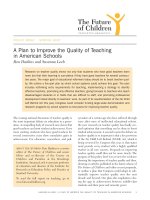4 2 1 equality in american schools (social studies)
Bạn đang xem bản rút gọn của tài liệu. Xem và tải ngay bản đầy đủ của tài liệu tại đây (3.78 MB, 14 trang )
Suggested levels for Guided Reading, DRA,™
Lexile,® and Reading Recovery™ are provided
in the Pearson Scott Foresman Leveling Guide.
by Lillian Forman
Genre
Expository
nonfiction
Comprehension
Skills and Strategy
• Cause and Effect
• Sequence
• Prior Knowledge
Text Features
•
•
•
•
Captions
Labels
Heads
Glossary
Scott Foresman Reading Street 4.2.1
ISBN 0-328-13429-5
ì<(sk$m)=bdecji< +^-Ä-U-Ä-U
Reader
Response
EQUALITY
IN
1.
Use a chart similar to the
one below to tell
AMERICAN
SCHOOLS
some causes of the fight for equality for African
Americans. What are some of the effects?
Cause Forman
by Lillian
Effect
2. What did you know about segregation before
reading this book? How did that help you while
you were reading?
3. Define the word legal. Then add a prefix to make
it mean its opposite. Add a suffix to make it a
verb. Use the dictionary to help you.
4. Using the section headings, find out how many
years passed between the time the Fourteenth
Amendment was passed and the end of
Reconstruction.
Editorial Offices: Glenview, Illinois • Parsippany, New Jersey • New York, New York
Sales Offices: Needham, Massachusetts • Duluth, Georgia • Glenview, Illinois
Coppell, Texas • Ontario, California • Mesa, Arizona
1868
The Fourteenth Amendment
Before the 1950s the laws of some states
forced African Americans to use different
facilities from those that white Americans used.
They had to drink from separate water fountains,
eat in separate restaurants, go to separate
hospitals, and learn in separate schools.
In 1868 the Fourteenth Amendment to the
Constitution of the United States officially
recognized that African Americans, recently
freed from slavery, were citizens. It gave them all
the rights of citizens, including “equal protection
under the law.” The Fifteenth Amendment,
passed in 1870, made it illegal for anyone to
prevent a citizen from voting because of race.
Every effort has been made to secure permission and provide appropriate credit for
photographic material. The publisher deeply regrets any omission and pledges to
correct errors called to its attention in subsequent editions.
Segregated movie
theater
Unless otherwise acknowledged, all photographs are the property of Scott Foresman,
a division of Pearson Education.
Photo locators denoted as follows: Top (T), Center (C), Bottom (B), Left (L), Right (R),
Background (Bkgdv)
Opener: Getty Images; 1 Library of Congress; 3 Library of Congress; 4 Library of
Congress; 5 Getty Images; 6 Library of Congress; 7 Corbis; 8 Library of Congress;
11 Getty Images; 12–13 Corbis; 14 Getty Images; 16 Library of Congress; 18–19 Getty
Images; 21 Corbis, Library of Congress; 22 Getty Images
ISBN: 0-328-13429-5
Copyright © Pearson Education, Inc.
All Rights Reserved. Printed in the United States of America. This publication is
protected by Copyright, and permission should be obtained from the publisher
prior to any prohibited reproduction, storage in a retrieval system, or transmission
in any form by any means, electronic, mechanical, photocopying, recording, or
likewise. For information regarding permission(s), write to: Permissions Department,
Scott Foresman, 1900 East Lake Avenue, Glenview, Illinois 60025.
2 3 4 5 6 7 8 9 10 V0G1 14 13 12 11 10 09 08 07 06 05
3
1865-1877
Reconstruction
There were many acts of discrimination
against African Americans. After the Civil War
ended on April 26, 1865, the U.S. government
sent soldiers to the South. They were there to
protect African Americans and to make sure
that no one prevented them from voting.
During this period, called Reconstruction, many
African Americans became leaders in their state
governments and representatives in the U.S.
Congress.
Reconstruction ended in 1877, and the
federal troops withdrew. This left African
Americans unprotected. Many white Southerners
wanted African Americans to live in separate
communities. They kept African Americans
from voting. As a result, after Reconstruction,
people who had supported the Confederacy still
governed the South. These legislators wanted
to keep African American and white people
separate. They turned such practices into laws.
Soldiers of different ethnic backgrounds
at a camp in Pennsylvania
4
5
1896
Separate but Equal
In the late 1800s the Supreme Court said that
segregation of African Americans and white
people was in agreement with the Constitution,
as long as they were separate but equal. The
places for African Americans had to be equal to
those for white people.
Did this really mean that African Americans
had the same rights as white people? Suppose
you find out that a group of students has taken
over a table in the cafeteria. When you try to sit
there, the group tells you to go somewhere else
even if there is room. They point out that the
other tables are the same. As a result you feel
that the members of the group think that they
are better than you and do not want you around.
The doctrine of “separate but equal” does
not make segregation right. Political leaders of
the late 1800s failed to provide equal facilities
for African Americans. Little money was spent
on African American facilities. African American
schools, for example, were not as good as those
used by white people.
Perhaps the most important public facility is
school. It is in school that people learn about
citizenship and prepare themselves for the
future. It is in school that people learn about
their own culture as well as other people’s
cultures. A poor school leaves its students at a
disadvantage.
Separate but Equal?
Do you think the
students in these
pictures have equal
opportunities?
6
7
1909-Present
NAACP
In the mid-1920s African Americans in a
group called the National Association for the
Advancement of Colored People (NAACP)
decided to do something about this inequality.
James Weldon Johnson, a poet, led the group
in a series of lawsuits to force school boards
to spend as much money on African American
schools as they did on white schools.
These lawsuits were also meant to start
integration, or the inclusion of people of all
racial backgrounds in public places. The NAACP
planned to do this in three ways:
• by advertising to the American public how
African Americans were discriminated against
• by showing African Americans that they could
fight against inequality
• by making it so expensive to provide
“separate but equal” facilities that white
Southern taxpayers would accept the idea
of integration
The NAACP was not able to carry out this plan
at the time. They needed more money and more
African American lawyers to do so. Fortunately,
in the 1930s, a group of African American leaders
took up the challenge.
James Weldon Johnson
8
9
One of these leaders was a lawyer named
Thurgood Marshall. He worked with another
African American lawyer, Charles Hamilton
Houston, to fight segregation in public schools.
At first Marshall and Houston tried to win
equal conditions for African American graduate
students, or people continuing their studies
after college. They felt that white judges would
respect the achievements of these young people.
Marshall and Houston went on to win many
cases. Two of the most important victories were
in the late 1940s. They both involved aspiring
lawyers—Herman Sweatt and George McLaurin.
Herman Sweatt applied to the University of
Texas School of Law and was rejected. True to the
doctrine of separate but equal, the state of Texas
gave the university money to build a law school
for African Americans. Until the new school was
built, however, Sweatt had to attend a makeshift
school in the basement of a building. When the
new school was built, it was not as good as the
University of Texas School of Law.
Thurgood Marshall
10
11
George McLaurin is forced
to sit alone in a classroom of
white students.
George McLaurin applied to the University of
Oklahoma. Since Oklahoma had no law school
for African Americans, the university had to
accept McLaurin as a student. He sat in the same
classroom as white students, but he sat alone.
In 1950 Marshall brought these cases to the
Supreme Court and won. In Sweatt’s case, the
Supreme Court justices agreed that the facility
for African American students was not equal to
the one for white students. In McLaurin’s case,
they recognized that sitting alone prevented him
from participating in class.
The Supreme Court ruled that Sweatt and
McLaurin should be treated the same as other
students. However, separate but equal facilities
were still allowed in other places.
12
These Supreme Court rulings gave Marshall
a way to fight segregation in elementary and
high schools. The rulings proved that McLaurin’s
isolation within the classroom had made his
education inferior. Marshall hoped that this
would make it easier for the NAACP to show that
all forms of segregation were harmful.
13
1951-1954
Brown v. Board of Education
Many parents asked their local NAACP to
help them get better school conditions for
their children. Some parents just wanted their
segregated schools to be as good as the white
schools. Marshall and other NAACP leaders
persuaded these people to demand that their
children be admitted to white schools.
Oliver Brown of Topeka, Kansas, did not want
his nine-year-old daughter, Linda, to have to
cross train tracks and a busy street to get to her
bus stop. At first he wanted safer transportation
for her, but then he realized that the white
school was only a few blocks away. It made more
sense to ask that Linda be allowed to attend that
school.
Linda Brown’s case was first tried in the U.S.
District Court for the district of Kansas in 1951.
This court agreed that segregation made African
American children feel less valued. However,
Linda Brown still was not allowed to go to school
with the white students.
Linda Brown, as a child (above)
Cheryl Brown Henderson, Linda’s
sister, speaking at a celebration
fifty years after the Brown v. Board
of Education decision, along with
President George W. Bush (left)
14
15
Supreme Court justices,
1953 (left) and a newspaper
announcing the Court’s
decision (below)
In 1952 Thurgood Marshall brought Brown’s
case before the Supreme Court. The Court did
not make a decision at that time. The case was
opened again in 1953 and was argued using the
Fourteenth Amendment, which gives all citizens,
of any ethnic background, equal rights and equal
protection under the law. In 1954 Chief Justice
Earl Warren read the Court’s unanimous, or fully
agreed upon, decision in favor of Linda Brown.
The Court concluded that separate schools are
unequal. It also stated that anyone forced to
go to a segregated school is “deprived of the
equal protection of the laws guaranteed by the
Fourteenth Amendment.”
16
This landmark decision was a great victory for
African Americans, but it was just the beginning
of a long and difficult struggle. The Supreme
Court justices knew that many white people
would fight against allowing African American
children into their schools. They decided that
integration should take place in a slow but
steady manner.
17
Southern politicians found three ways to fight
the Brown v. Board of Education decision. One
of these tactics was to do nothing about helping
integration along. Another was to refuse to obey
the laws against segregation. The third involved
violence. Mobs of people threatened and
insulted African American students who tried to
attend white schools.
18
Shortly after the Supreme Court had declared
school segregation unconstitutional, a group of
people in Mississippi formed the White Citizens
Council to fight integration. The members of the
White Citizens Council and similar groups took
legal and illegal measures to prevent African
American children from entering white schools.
Besides handing out leaflets to advertise their
own point of view, they hurt those who did not
agree with them. The members boycotted, or
refused to buy from, businesses whose owners
did not support segregation. They fired African
American employees who tried to insist on the
rights of their children.
19
Today
The Fight Continues
The people who were against integration
became more active. Newspapers showed
photographs of mobs jeering at African
American students, who only wanted an equal
education.
Instead of being discouraged, African
Americans continued to fight. New laws were
made, ending segregation in all public facilities.
In 1967 Thurgood Marshall became the first
African American U.S. Supreme Court justice.
Integration did not progress quickly, though.
In 2004, on the fiftieth anniversary of the Brown
v. Board of Education decision, educators met
at Central Missouri State University. They found
that schools were becoming
segregated again, partly
because our nation had not
been paying attention to
desegregation. The educators
restated the importance of
diversity in U.S. schools and
vowed to renew the fight to
make it happen.
20
Children of different
ethnic backgrounds
share the same
classroom as a result
of desegregation.
21
Now Try This
Make a Difference at Your School
When asking for integration of the schools,
Thurgood Marshall reminded the Supreme Court
justices that African American and white children
played together on the way to and from school.
He asked what harm it would cause if they also
went to school together. In making this point,
Marshall suggested that if young people went to
school together, they would remain friendly and
helpful to each other.
What can you do to help people of different
ethnicities and cultures in
your school? Are
some students being
left out of social
groups? Is anyone
having difficulty with
language? List the
problems that you have
observed. Interview
students of other
cultures to find out
what they need in order
to be happy at your
school.
to Do It!
w
o
H
s
’
e
r
He
1. First, set a goal. You will need to focus on
a problem that seems possible to solve. For
example, you might decide to help students
with language differences.
2. Next, make a plan. List the steps needed to
solve the problem. Enlist the help of your
classmates. Ask your teachers for suggestions.
What else might help you make a plan?
3. Form a group and assign a task to each
member of the group. If you want to deal
with a language difference, the group might
help a student learn English by
holding practice conversations
with him or her. One member
of the group might pick a topic
and another might make a list of
English words that suit the topic.
All members of the group should
take part in the conversations.
4. You might want to turn the group
into a club. Think of a name for
the club. How will the name
reflect the club’s goal?
Thurgood Marshall on the
cover of Time magazine
22
23
Glossary
aspiring adj. having an
ambition for something;
desiring earnestly;
seeking.
discrimination n. the
act of showing an unfair
difference in treatment.
diversity n. variety.
doctrine n. what is
taught as true by a
church, nation, or group
of persons; belief.
Reader Response
integration n. inclusion
of people of all ethnic
backgrounds on an
equal basis in schools,
parks, neighborhoods,
and so on.
1. Use a chart similar to the one below to tell
some causes of the fight for equality for African
Americans. What are some of the effects?
Cause
Effect
jeering v. laughing
at rudely or unkindly;
mocking; scoffing.
tactics n. ways to gain
advantage or success;
methods.
2. What did you know about segregation before
reading this book? How did that help you while
you were reading?
3. Define the word legal. Then add a prefix to make
it mean its opposite. Add a suffix to make it a
verb. Use the dictionary to help you.
4. Using the section headings, find out how many
years passed between the time the Fourteenth
Amendment was passed and the end of
Reconstruction.
24









